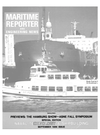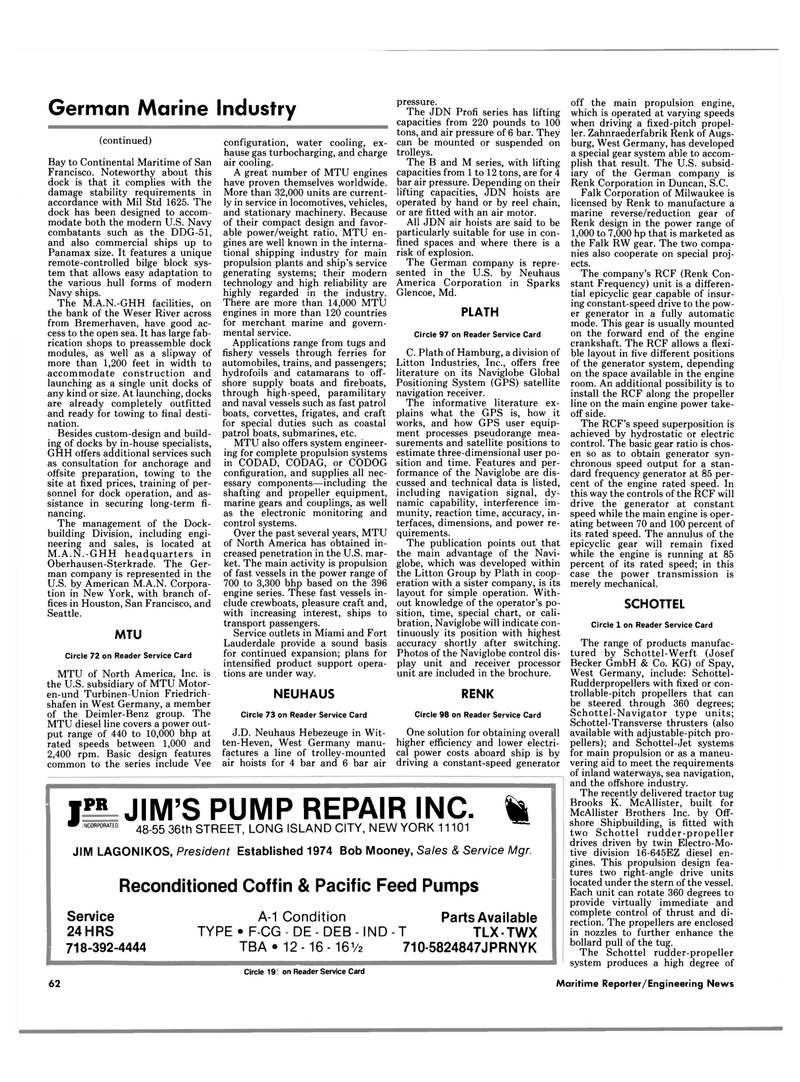
Page 60: of Maritime Reporter Magazine (September 1986)
Read this page in Pdf, Flash or Html5 edition of September 1986 Maritime Reporter Magazine
German Marine Industry (continued)
Bay to Continental Maritime of San
Francisco. Noteworthy about this dock is that it complies with the damage stability requirements in accordance with Mil Std 1625. The dock has been designed to accom- modate both the modern U.S. Navy combatants such as the DDG-51, and also commercial ships up to
Panamax size. It features a unique remote-controlled bilge block sys- tem that allows easy adaptation to the various hull forms of modern
Navy ships.
The M.A.N.-GHH facilities, on the bank of the Weser River across from Bremerhaven, have good ac- cess to the open sea. It has large fab- rication shops to preassemble dock modules, as well as a slipway of more than 1,200 feet in width to accommodate construction and launching as a single unit docks of any kind or size. At launching, docks are already completely outfitted and ready for towing to final desti- nation.
Besides custom-design and build- ing of docks by in-house specialists,
GHH offers additional services such as consultation for anchorage and offsite preparation, towing to the site at fixed prices, training of per- sonnel for dock operation, and as- sistance in securing long-term fi- nancing.
The management of the Dock- building Division, including engi- neering and sales, is located at
M.A.N.-GHH headquarters in
Oberhausen-Sterkrade. The Ger- man company is represented in the
U.S. by American M.A.N. Corpora- tion in New York, with branch of- fices in Houston, San Francisco, and
Seattle.
MTU
Circle 72 on Reader Service Card
MTU of North America, Inc. is the U.S. subsidiary of MTU Motor- en-und Turbinen-Union Friedrich- shafen in West Germany, a member of the Deimler-Benz group. The
MTU diesel line covers a power out- put range of 440 to 10,000 bhp at rated speeds between 1,000 and 2,400 rpm. Basic design features common to the series include Vee configuration, water cooling, ex- hause gas turbocharging, and charge air cooling.
A great number of MTU engines have proven themselves worldwide.
More than 32,000 units are current- ly in service in locomotives, vehicles, and stationary machinery. Because of their compact design and favor- able power/weight ratio, MTU en- gines are well known in the interna- tional shipping industry for main propulsion plants and ship's service generating systems; their modern technology and high reliability are highly regarded in the industry.
There are more than 14,000 MTU engines in more than 120 countries for merchant marine and govern- mental service.
Applications range from tugs and fishery vessels through ferries for automobiles, trains, and passengers; hydrofoils and catamarans to off- shore supply boats and fireboats, through high-speed, paramilitary and naval vessels such as fast patrol boats, corvettes, frigates, and craft for special duties such as coastal patrol boats, submarines, etc.
MTU also offers system engineer- ing for complete propulsion systems in CODAD, CODAG, or CODOG configuration, and supplies all nec- essary components—including the shafting and propeller equipment, marine gears and couplings, as well as the electronic monitoring and control systems.
Over the past several years, MTU of North America has obtained in- creased penetration in the U.S. mar- ket. The main activity is propulsion of fast vessels in the power range of 700 to 3,300 bhp based on the 396 engine series. These fast vessels in- clude crewboats, pleasure craft and, with increasing interest, ships to transport passengers.
Service outlets in Miami and Fort
Lauderdale provide a sound basis for continued expansion; plans for intensified product support opera- tions are under way.
NEUHAUS
Circle 73 on Reader Service Card
J.D. Neuhaus Hebezeuge in Wit- ten-Heven, West Germany manu- factures a line of trolley-mounted air hoists for 4 bar and 6 bar air pressure.
The JDN Profi series has lifting capacities from 220 pounds to 100 tons, and air pressure of 6 bar. They can be mounted or suspended on trolleys.
The B and M series, with lifting capacities from 1 to 12 tons, are for 4 bar air pressure. Depending on their lifting capacities, JDN hoists are operated by hand or by reel chain, or are fitted with an air motor.
All JDN air hoists are said to be particularly suitable for use in con- fined spaces and where there is a risk of explosion.
The German company is repre- sented in the U.S. by Neuhaus
America Corporation in Sparks
Glencoe, Md.
PLATH
Circle 97 on Reader Service Card
C. Plath of Hamburg, a division of
Litton Industries, Inc., offers free literature on its Naviglobe Global
Positioning System (GPS) satellite navigation receiver.
The informative literature ex- plains what the GPS is, how it works, and how GPS user equip- ment processes pseudorange mea- surements and satellite positions to estimate three-dimensional user po- sition and time. Features and per- formance of the Naviglobe are dis- cussed and technical data is listed, including navigation signal, dy- namic capability, interference im- munity, reaction time, accuracy, in- terfaces, dimensions, and power re- quirements.
The publication points out that the main advantage of the Navi- globe, which was developed within the Litton Group by Plath in coop- eration with a sister company, is its layout for simple operation. With- out knowledge of the operator's po- sition, time, special chart, or cali- bration, Naviglobe will indicate con- tinuously its position with highest accuracy shortly after switching.
Photos of the Naviglobe control dis- play unit and receiver processor unit are included in the brochure.
RENK
Circle 98 on Reader Service Card
One solution for obtaining overall higher efficiency and lower electri- cal power costs aboard ship is by driving a constant-speed generator
IPR JIM'S PUMP REPAIR INC. % 9 NC0RP0RATED 48-55 36th STREET, LONG ISLAND CITY, NEW YORK 11101
JIM LAGONIKOS, President Established 1974 Bob Mooney, Sales & Service Mgr.
Reconditioned Coffin & Pacific Feed Pumps
Service A-1 Condition Parts Available 24HRS TYPE* F-CG - DE - DEB - IND - T TLX-TWX 718-392-4444 TBA • 12 -16 - I6V2 710-5824847JPRNYK
Circle 189 on Reader Service Card off the main propulsion engine, which is operated at varying speeds when driving a fixed-pitch propel- ler. Zahnraederfabrik Renk of Augs- burg, West Germany, has developed a special gear system able to accom- plish that result. The U.S. subsid- iary of the German company is
Renk Corporation in Duncan, S.C.
Falk Corporation of Milwaukee is licensed by Renk to manufacture a marine reverse/reduction gear of
Renk design in the power range of 1,000 to 7,000 hp that is marketed as the Falk RW gear. The two compa- nies also cooperate on special proj- ects.
The company's RCF (Renk Con- stant Frequency) unit is a differen- tial epicyclic gear capable of insur- ing constant-speed drive to the pow- er generator in a fully automatic mode. This gear is usually mounted on the forward end of the engine crankshaft. The RCF allows a flexi- ble layout in five different positions of the generator system, depending on the space available in the engine room. An additional possibility is to install the RCF along the propeller line on the main engine power take- off side.
The RCF's speed superposition is achieved by hydrostatic or electric control. The basic gear ratio is chos- en so as to obtain generator syn- chronous speed output for a stan- dard frequency generator at 85 per- cent of the engine rated speed. In this way the controls of the RCF will drive the generator at constant speed while the main engine is oper- ating between 70 and 100 percent of its rated speed. The annulus of the epicyclic gear will remain fixed while the engine is running at 85 percent of its rated speed; in this case the power transmission is merely mechanical.
SCHOTTEL
Circle 1 on Reader Service Card
The range of products manufac- tured by Schottel-Werft (Josef
Becker GmbH & Co. KG) of Spay,
West Germany, include: Schottel-
Rudderpropellers with fixed or con- trollable-pitch propellers that can be steered through 360 degrees;
Schottel-Navigator type units;
Schottel-Transverse thrusters (also available with adjustable-pitch pro- pellers); and Schottel-Jet systems for main propulsion or as a maneu- vering aid to meet the requirements of inland waterways, sea navigation, and the offshore industry.
The recently delivered tractor tug
Brooks K. McAllister, built for
McAllister Brothers Inc. by Off- shore Shipbuilding, is fitted with two Schottel rudder-propeller drives driven by twin Electro-Mo- tive division 16-645EZ diesel en- gines. This propulsion design fea- tures two right-angle drive units located under the stern of the vessel.
Each unit can rotate 360 degrees to provide virtually immediate and complete control of thrust and di- rection. The propellers are enclosed in nozzles to further enhance the bollard pull of the tug.
The Schottel rudder-propeller system produces a high degree of 62 Maritime Reporter/Engineering News

 59
59

 61
61
